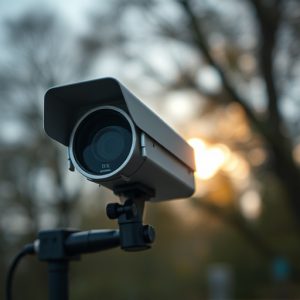Mastering Motion Activated Spy Cameras: Signal Detection & Longevity Tips
Electromagnetic signals are key to detecting hidden surveillance devices like motion-activated spy c…….
Electromagnetic signals are key to detecting hidden surveillance devices like motion-activated spy cameras. Understanding these signals, including their frequency and power consumption patterns, allows for effective detection through specialized equipment. High-end spy cameras offer extended battery life due to optimized settings, while regular maintenance ensures longer service. Legal and ethical considerations surrounding their use are critical, with many countries having stringent privacy laws that must be navigated responsibly, focusing on the longevity of the motion-activated spy camera's operational lifespan.
“Uncover the secrets of surveillance device electromagnetic signal detection, a comprehensive guide designed for tech-savvy enthusiasts. From understanding the basics of electromagnetic signals to mastering the art of motion-activated spy camera operation, this article offers valuable insights.
Explore effective strategies for optimizing battery life in these discreet devices, ensuring long-lasting surveillance. Learn about cutting-edge tools and techniques for signal detection, enabling you to identify emissions accurately. Additionally, we delve into legal considerations and ethical practices surrounding the use of surveillance technology, emphasizing responsible deployment.”
- Understanding Electromagnetic Signals: The Basics
- Motion Activated Spy Cameras: How They Work and Their Signal Requirements
- Optimizing Battery Life: Strategies for Long-Lasting Surveillance
- Detecting Signals: Tools and Techniques for Emission Identification
- Legal Considerations and Ethical Use of Surveillance Devices
Understanding Electromagnetic Signals: The Basics
Electromagnetic signals are an essential part of modern technology, often invisible yet all-pervasive. Understanding these signals is crucial when it comes to detecting hidden surveillance devices like motion-activated spy cameras. These devices operate by emitting electromagnetic radiation, typically in the form of radio waves, to transmit video and audio data. The motion sensor triggers the camera, which then captures and transmits footage, often with a built-in battery for extended life, such as those found in motion-activated spy cameras.
When searching for such devices, it’s important to be aware that electromagnetic signals can come from various sources, not just surveillance equipment. This knowledge is key to effective detection. By understanding the basics of electromagnetic radiation and its behavior, you can employ specific techniques to identify unusual signals, especially those with distinctive patterns or strengths indicative of hidden spy cameras, including their battery life indicators.
Motion Activated Spy Cameras: How They Work and Their Signal Requirements
Motion Activated Spy Cameras, also known as motion-triggered or passive infrared (PIR) cameras, are designed to capture footage only when movement is detected. This technology uses a combination of sensors and algorithms to identify changes in heat signatures, which indicate the presence of an object or person moving within range. When triggered, these cameras capture high-resolution video and often include various recording options, such as loop recording or cloud storage.
These devices require specific electromagnetic signal conditions to function effectively. They rely on a combination of infrared (IR) LEDs for illumination and motion sensors that emit and detect IR radiation. The Motion Activated Spy Camera Battery Life is generally dependent on the quality of the sensor, the recording resolution, and the camera’s power-saving modes. High-end models can offer extended battery life by optimizing these factors, ensuring continuous surveillance over longer periods without needing frequent recharging or battery replacement.
Optimizing Battery Life: Strategies for Long-Lasting Surveillance
Surveillance devices, especially motion-activated spy cameras, rely on battery power for extended operations in remote locations or when left unattended. Optimizing battery life is crucial to ensure continuous monitoring without interruption. One effective strategy is to employ energy-efficient components and design choices. This includes using low-power sensors, processors, and display technologies where applicable. Additionally, enabling power-saving modes during periods of inactivity can significantly extend battery duration.
Regular maintenance and calibration also play a vital role in managing battery health. Ensuring the device’s motion sensor is properly calibrated reduces false triggers, thereby minimizing unnecessary energy consumption. Moreover, using high-quality batteries and keeping them charged at optimal levels will contribute to longer overall service life. In the case of motion-activated cameras, strategic placement to capture only relevant activity can further conserve power, enhancing battery life and ensuring efficient surveillance.
Detecting Signals: Tools and Techniques for Emission Identification
Detecting signals from surveillance devices, such as motion-activated spy cameras, requires a thoughtful blend of tools and techniques. One crucial method is to use electromagnetic signal detectors designed to identify specific frequencies associated with various devices. These detectors can pinpoint the exact location of the signal source, helping you track down hidden cameras or other surveillance equipment.
When it comes to motion-activated spy cameras, understanding their battery life and power consumption patterns can be a game-changer. Many such devices operate on low-power modes when not detecting motion, making signal detection easier during periods of inactivity. Leveraging this knowledge alongside specialized tools allows for more effective identification and neutralization of these devices, ensuring your privacy remains intact.
Legal Considerations and Ethical Use of Surveillance Devices
When utilizing surveillance devices, it’s paramount to navigate the legal and ethical landscapes that govern their use. Many countries have strict regulations surrounding privacy rights, with laws specifically targeting covert recording and surveillance. For instance, some jurisdictions require explicit consent from all parties involved for any form of monitoring, while others have restrictions on where and how such devices can be deployed.
The ethical implications are equally significant, particularly when considering the potential invasion of privacy, especially in public spaces. Motion-activated spy cameras, with their promise of extended battery life, should only be employed responsibly, respecting individual freedoms. Ethical use includes obtaining consent, securing data responsibly, and ensuring these devices are not misused for malicious purposes or to invade personal spaces without knowledge or permission.
In conclusion, understanding electromagnetic signals is key to successful surveillance device deployment. From motion-activated spy cameras, which rely on specific signal requirements for activation, to battery life optimization strategies, ensuring discreet and effective monitoring is a delicate balance. By mastering signal detection techniques and staying informed about legal boundaries, users can leverage technology responsibly while maintaining privacy and security. For instance, focusing on efficient energy management in Motion Activated Spy Cameras can significantly extend their operational lifespan, making them invaluable tools for various surveillance needs.


